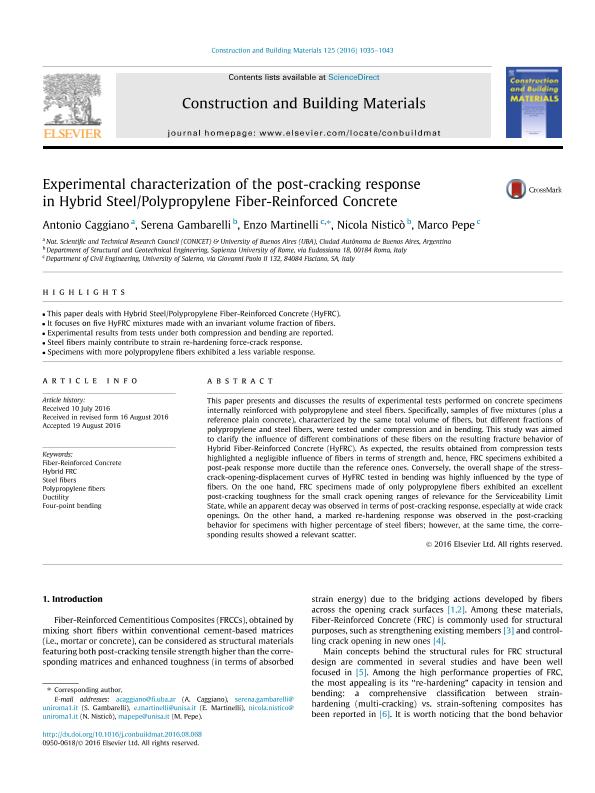Mostrar el registro sencillo del ítem
dc.contributor.author
Caggiano, Antonio

dc.contributor.author
Gambarelli, Serena
dc.contributor.author
Martinelli, Enzo

dc.contributor.author
Nisticò, Nicola
dc.contributor.author
Pepe, Marco
dc.date.available
2018-08-15T19:31:22Z
dc.date.issued
2016-10
dc.identifier.citation
Caggiano, Antonio; Gambarelli, Serena; Martinelli, Enzo; Nisticò, Nicola; Pepe, Marco; Experimental characterization of the post-cracking response in Hybrid Steel/Polypropylene Fiber-Reinforced Concrete; Elsevier; Construction And Building Materials; 125; 10-2016; 1035-1043
dc.identifier.issn
0950-0618
dc.identifier.uri
http://hdl.handle.net/11336/55722
dc.description.abstract
This paper presents and discusses the results of experimental tests performed on concrete specimens internally reinforced with polypropylene and steel fibers. Specifically, samples of five mixtures (plus a reference plain concrete), characterized by the same total volume of fibers, but different fractions of polypropylene and steel fibers, were tested under compression and in bending. This study was aimed to clarify the influence of different combinations of these fibers on the resulting fracture behavior of Hybrid Fiber-Reinforced Concrete (HyFRC). As expected, the results obtained from compression tests highlighted a negligible influence of fibers in terms of strength and, hence, FRC specimens exhibited a post-peak response more ductile than the reference ones. Conversely, the overall shape of the stress-crack-opening-displacement curves of HyFRC tested in bending was highly influenced by the type of fibers. On the one hand, FRC specimens made of only polypropylene fibers exhibited an excellent post-cracking toughness for the small crack opening ranges of relevance for the Serviceability Limit State, while an apparent decay was observed in terms of post-cracking response, especially at wide crack openings. On the other hand, a marked re-hardening response was observed in the post-cracking behavior for specimens with higher percentage of steel fibers; however, at the same time, the corresponding results showed a relevant scatter.
dc.format
application/pdf
dc.language.iso
eng
dc.publisher
Elsevier

dc.rights
info:eu-repo/semantics/openAccess
dc.rights.uri
https://creativecommons.org/licenses/by-nc-sa/2.5/ar/
dc.subject
Ductility
dc.subject
Fiber-Reinforced Concrete
dc.subject
Four-Point Bending
dc.subject
Hybrid Frc
dc.subject
Polypropylene Fibers
dc.subject
Steel Fibers
dc.subject.classification
Ingeniería de los Materiales

dc.subject.classification
Ingeniería de los Materiales

dc.subject.classification
INGENIERÍAS Y TECNOLOGÍAS

dc.title
Experimental characterization of the post-cracking response in Hybrid Steel/Polypropylene Fiber-Reinforced Concrete
dc.type
info:eu-repo/semantics/article
dc.type
info:ar-repo/semantics/artículo
dc.type
info:eu-repo/semantics/publishedVersion
dc.date.updated
2018-08-15T14:24:10Z
dc.journal.volume
125
dc.journal.pagination
1035-1043
dc.journal.pais
Países Bajos

dc.journal.ciudad
Amsterdam
dc.description.fil
Fil: Caggiano, Antonio. Consejo Nacional de Investigaciones Científicas y Técnicas; Argentina. Universidad de Buenos Aires; Argentina
dc.description.fil
Fil: Gambarelli, Serena. Università degli studi di Roma "La Sapienza"; Italia
dc.description.fil
Fil: Martinelli, Enzo. Universita di Salerno; Italia
dc.description.fil
Fil: Nisticò, Nicola. Università degli studi di Roma "La Sapienza"; Italia
dc.description.fil
Fil: Pepe, Marco. Universita di Salerno; Italia
dc.journal.title
Construction And Building Materials

dc.relation.alternativeid
info:eu-repo/semantics/altIdentifier/doi/https://dx.doi.org/10.1016/j.conbuildmat.2016.08.068
dc.relation.alternativeid
info:eu-repo/semantics/altIdentifier/url/https://www.sciencedirect.com/science/article/pii/S0950061816313319
Archivos asociados
